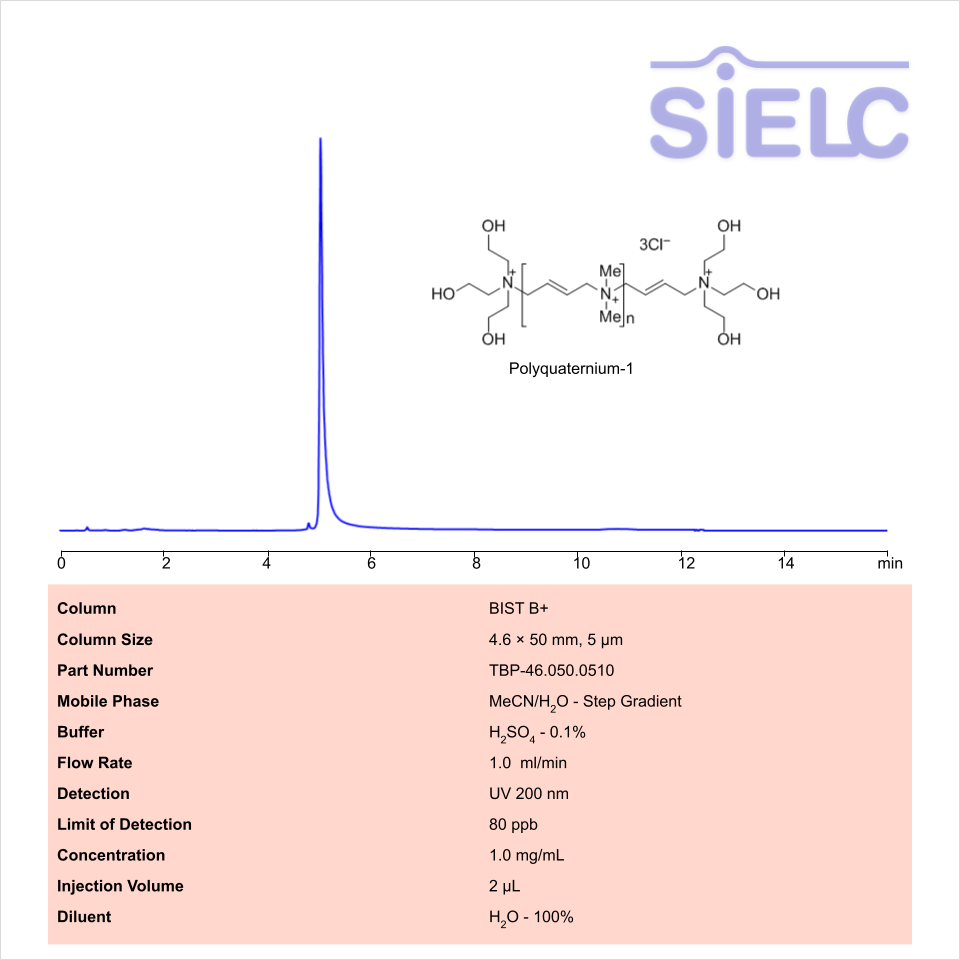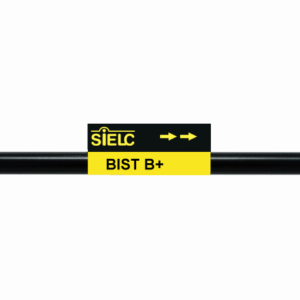
| CAS Number | 75345-27-6 |
|---|---|
| Molecular Formula | C22H48Cl3N3O6 |
| Molecular Weight | 557.0 |
| InChI Key | OTIWYSKRSMXGNK-VHJGTCNUSA-K |
| Synonyms |
|
Applications:
HPLC Method for Analysis of Polyquaternium-1 (Polidronium Chloride) Using a BIST B+ Column
September 23, 2025
HPLC Method for Polyquaternium-1 on BIST B+ by SIELC Technologies
High Performance Liquid Chromatography (HPLC) Method for Analysis of Polyquaternium-1
Polyquaternium-1, also known as Polidronium Chloride, is an antimicrobial preservative with the molecular formula C22H48Cl3N3O6. It is used in ophthalmic products, skincare, and hair care.
Polyquaternium-1 can be retained and analyzed using the BIST B+ stationary phase column. The analysis utilizes a gradient method with a simple mobile phase consisting of water, acetonitrile (MeCN) and a sulfuric acid buffer. Detection is performed using UV.
Note: Step gradient methods involve sudden changes in mobile phase composition, which can cause baseline disturbances and system-related signals. To ensure accurate interpretation, integration, and data processing, it is necessary to account for this effect. A blank sample (sample diluent) must be analyzed prior to the sample of interest. After all chromatograms are generated, the blank chromatogram should be subtracted from the sample chromatogram before performing integration.
*LOD was determined for this combination of instrument, method, and analyte, and it can vary from one laboratory to another even when the same general type of analysis is being performed.
Mobile Phase Conditions
If using three channels on the instrument:
Channel A: H₂O
Channel B: MeCN
Channel C: H2SO₄ 1% in H2O
| Time (min) | A – H2O (%) | B – MeCN (%) | C – H2SO4 1% in H2O (%) | Notes |
|---|---|---|---|---|
| 0 | 50 | 40 | 10 | Starting Conditions |
| 2 | 50 | 40 | 10 | Starting Conditions End |
| 2.01 | 90 | 0 | 10 | 1st Step Gradient |
| 8 | 90 | 0 | 10 | 1st Step Gradient End |
| 8.01 | 50 | 40 | 10 | 2nd Step Gradient/Column Equilibration |
| 16 | 50 | 40 | 10 | End of Run |
If using premixed mobile phase (two channels):
Mobile Phase A: 0.1% H2SO₄ in MeCN/H₂O (40:60)
Mobile Phase B: 0.1% H2SO₄ in H₂O
| Time (min) | Mobile Phase A (%) | Mobile Phase B (%) | Notes |
|---|---|---|---|
| 0 | 100 | 0 | Starting Conditions |
| 2 | 100 | 0 | Starting Conditions End |
| 2.01 | 0 | 100 | 1st Step Gradient |
| 8 | 0 | 100 | 1st Step Gradient End |
| 8.01 | 100 | 0 | 2nd Step Gradient/Column Equilibration |
| 16 | 100 | 0 | End of Run |
| Column | BIST B+, 4.6 x 50 mm, 5 µm, 100 A, dual ended |
| Mobile Phase | MeCN – Gradient |
| Buffer | Sulfuric Acid |
| Flow Rate | 1.0 ml/min |
| Detection | UV 200 nm |
| Class of Compounds | Preservative |
| Analyzing Compounds | Polyquaternium-1 |
Application Column
BIST B+
Column Diameter: 4.6 mm
Column Length: 50 mm
Particle Size: 5 µm
Pore Size: 100 A
Column options: dual ended



